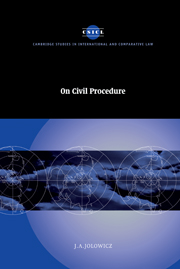Book contents
- Frontmatter
- Contents
- Preface
- List of abbreviations
- Introduction
- I The litigation process
- II Protection of diffuse, fragmented and collective interests
- 5 Introduction
- 6 Aspects of U.S. and French law
- 7 English law
- III Procedural modes
- IV The parties and the judge
- V Recourse against judgments
- VI Procedural reform
- Index
- CAMBRIDGE STUIDES IN INTERNATIONAL AND COMPARATIVE LAW
5 - Introduction
from II - Protection of diffuse, fragmented and collective interests
Published online by Cambridge University Press: 18 December 2009
- Frontmatter
- Contents
- Preface
- List of abbreviations
- Introduction
- I The litigation process
- II Protection of diffuse, fragmented and collective interests
- 5 Introduction
- 6 Aspects of U.S. and French law
- 7 English law
- III Procedural modes
- IV The parties and the judge
- V Recourse against judgments
- VI Procedural reform
- Index
- CAMBRIDGE STUIDES IN INTERNATIONAL AND COMPARATIVE LAW
Summary
Intermediate rights
It has always been true that the activities of some members of society will produce harmful consequences for others, individually or as members of the public or of a section of the public; it has also always been true that the law and the courts have played an important role in the control of behaviour and the regulation of such redress as may be available to those harmed or threatened with harm. Until comparatively recently, however, it has been sufficient to allow access to the courts only to a representative of the public – Attorney-General, ministere public or other official body - where the right affected is ‘public’, and only to the affected individual, as ‘owner’ of the right, where it is ‘private’. Now, however, changes in society itself and the law explosion of modern times have combined to create situations in which there is need to allow access to the courts on a wider basis. It is no longer sufficient to hold that only the official representative of the public, if anyone, may institute litigation where there is no private owner of a right able and willing to do so.
- Type
- Chapter
- Information
- On Civil Procedure , pp. 97 - 108Publisher: Cambridge University PressPrint publication year: 2000



